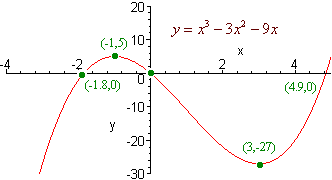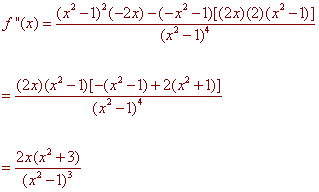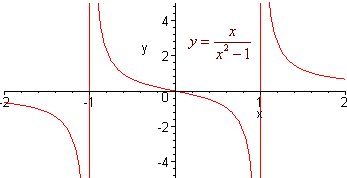Curve Sketching
A List of Interesting features of a Graph
Below is a list of features of a graph that may assist in curve sketching:
-
x-intercepts
-
y-intercepts
-
Domain and Range
-
Continuity
-
Vertical Asymptotes
-
Differentiability
-
Intervals of Increase and Decrease
-
Relative Extrema
-
Concavity
-
Inflection Points
-
Horizontal Asymptotes
Most graphs contain only some of these eleven features, so to
sketch a graph we find as many interesting features as possible and use these
features to sketch the graph.
Examples
Example 1:
Graph
y = x3 - 3x2 -9x
-
We find the x intercepts by factoring out the x and putting into the quadratic formula.
(-1.8,0), (0,0), (4.9,0)
-
Note that the y intercept is also (0,0).
-
The domain is R since this is a polynomial.
-
The function is continuous since it is a polynomial.
-
There are no vertical asymptotes since we have a polynomial.
-
The function is differentiable everywhere.
-
We find
f '(x) = 3x2 - 6x - 9 = 3(x - 3)(x + 1).
We see that f is increasing on (- ,-1)
and on (3,
,-1)
and on (3,  ).
f is decreasing on (-1,3)
).
f is decreasing on (-1,3)
-
By the first derivative test, f has a relative maximum at (-1,5) and a relative minimum at (3,-27).
-
f ''(x) = 6x - 6
so that f is concave down on (- ,1)
and concave up on (1,
,1)
and concave up on (1,  ).
).
-
f(x) has an inflection point at (1,-11).
-
f has no horizontal asymptotes.
The graph of f is shown below:

Example
Graph
x
y =
x2 - 1
Solution:
x-int at (0,0)
Same for y-int
(x2 - 1)(1) -
x(2x)
-x2 - 1
f '(x) =
=
(x2 - 1)2
(x2 - 1)2
Since the numerator is never zero, so there are no local extrema and f(x) is increasing when x > 1 or x < -1. Now take the second derivative

The second derivative is 0 when x = 0
and is positive when x is between - 1 and
0 or x
is greater than 1. This is where f(x)
is concave up. It is concave down
elsewhere except at 0 and ![]() 1.
1.
f(x) has a vertical asymptote at x = 1 and -1.
The horizontal asymptote is y = 0.
The graph is shown below.

Back to the calculus home page
Back to the math department home page
e-mail Questions and Suggestions